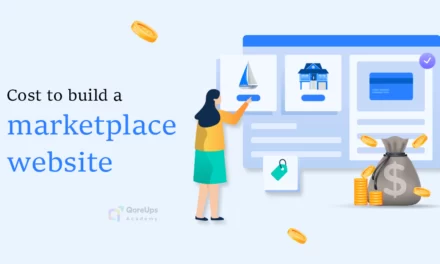Marketplace pricing! Have you ever wondered how this determines the success of your online marketplace?
Pricing plays an important role in staying competitive in the marketplace landscape.
So, how can you effectively choose the right pricing strategy while staying competitive?
In this blog, we will delve into different strategies that can help you to select the best pricing for your online marketplace platform.
Are you ready to explore these strategies and discover how you can thrive in the marketplace by setting optimal prices?
Together, let’s uncover the mysteries of marketplace pricing and aim for success!
Why Are Marketplace Pricing Strategies Essential for Success?
Whom to charge? From vendors or users? This is the major challenge many marketplace owners like you face.
To solve this problem you need a proper pricing strategy.
Most of the marketplace business fails because they failed to recognize from which user base they need to charge.
As most of the marketplaces are two-sided, it is important to understand from whom you should charge.
Thus, selecting the right pricing strategy is important for marketplace business. Also, pricing helps in maximizing the revenue model.
You’ll get out of the competition if you don’t know how to price your marketplace. For example, Sidecar Rideshare – is one of the first ridesharing services.
But, What happened to the Sidecar Rideshare service?
On 29 th of December 2015, Sidecar announced its shutdown.
The reason is other ride-sharing services like Uber and Lyft took over Sidecar. These 2 use their pricing strategy to attract both drivers and users.
This is the reason why you need a marketplace pricing strategy. Your marketplace’s success hangs on your pricing strategy.
Let’s see how to select the right pricing strategy for your marketplace business.
How Do You Choose The Right Pricing Strategy For Your Marketplace?
Imagine you’re embarking on a thrilling quest to find the perfect pricing strategy for your marketplace.
It’s a journey that requires a deep understanding of your target audience, their wants, and their financial boundaries.
You’ll dive into market research, deciphering their preferences and unraveling the threads of their purchasing behavior.
As you gather this treasure trove of knowledge, you’ll uncover invaluable insights that will shape your pricing strategy.
But that’s not all!
To navigate this terrain successfully, you must also venture into the realm of costs. It’s a daunting task, analyzing every expense like an intrepid explorer mapping uncharted territories.
By meticulously mapping your operational costs, marketing expenditures, and other overheads, you’ll gain a clear picture of the financial landscape.
This knowledge will guide you toward setting a pricing structure that covers these costs and ensures a healthy profit margin.
As you continue your expedition, you’ll encounter a colorful array of competitors along the way. Just as seasoned adventurers study the tactics of their rivals, you’ll analyze their pricing strategies.
You’ll unearth hidden gems of information, discover industry norms, and identify opportunities for differentiation. This knowledge will be your compass, helping you chart a unique course for your marketplace.
Now it’s time for experimentation, where you don the hat of a daring scientist in a bustling laboratory.
Test different pricing models and observe the impact on your customers’ reactions. A/B testing, surveys, or focus groups become your trusted tools, revealing precious data that shapes your decision-making process.
You’ll analyze the feedback with keen eyes, drawing valuable insights to refine your pricing strategy further.
In your quest for the perfect pricing strategy, you’ll encounter the notion of value. Like a skilled jeweler appraising rare gems, you’ll determine the worth of your marketplace in the eyes of your customers.
Does it offer unique features, exceptional service, or cater to a specialized niche?
Based on this assessment, you’ll ascertain whether a premium price can be justified, or if a more competitive approach is required.
But why settle for a single path when you can offer an entire menu of possibilities?
Just like an esteemed chef crafting a tantalizing feast, you’ll create pricing tiers or options to cater to different customer segments.
Basic, standard, and premium packages will entice a diverse range of customers, each with its own promises of value and tailored experiences.
However, the journey doesn’t end there.
Your pricing strategy is a living entity, requiring constant nurturing and adaptation.
Like a wise sage, you’ll monitor key metrics such as conversion rates, customer acquisition costs, and revenue per user.
This ongoing vigilance will empower you to make data-driven adjustments, ensuring your pricing strategy remains optimized over time.
Finding Your Perfect Fit: The Ideal Marketplace Pricing Strategy
In the vast and vibrant realm of online marketplaces, finding the perfect pricing strategy is akin to uncovering a hidden treasure trove.
Like a skilled adventurer, you must navigate myriad options, exploring diverse pricing models that suit your marketplace’s unique needs.
Let’s embark on this exhilarating journey together, delving into the depths of various pricing strategies.
Exploring Diverse Online Marketplace Pricing Models
Commission-based Pricing
- Charges a commission or transaction fee on each sale made through the marketplace.
- Provides a straightforward revenue stream.
- Incentivizes sellers to actively participate and aligns their success with yours.
- Attracts a wide range of sellers, offering diverse products or services.
Subscription-based Pricing
- Users pay a recurring fee for access to enhanced features or services.
- Generates predictable revenue streams.
- Creates a loyal customer base and fosters a sense of exclusivity.
- Works well for marketplaces with specialized content or ongoing value.
Freemium Pricing
- Offers a basic version of the marketplace for free.
- Provides premium features or upgrades at a cost.
- Attracts a large user base and creates a network effect.
- Encourages users to explore the value before committing to a paid offering.
Dynamic Pricing
- Adjusts prices based on real-time factors like demand and supply.
- Optimizes revenue and adapts to changing market dynamics.
- Requires robust algorithms and data analysis capabilities.
- Maximizes profit while ensuring competitiveness.
Peer-to-Peer (P2P) Pricing
- Allows individual users to set their own prices for products or services.
- Facilitates transactions and charges a fee or commission.
- Promotes engagement and a sense of community.
- Empowers users with control over pricing and personalized negotiations.
Tiered Pricing
- Offers multiple pricing tiers with different features or benefits.
- Caters to diverse customer segments with various budgets and preferences.
- Captures value from different market segments.
- Encourages customers to upgrade for additional perks.
As you traverse this landscape of marketplace pricing models, remember that finding the right fit requires experimentation and flexibility. Consider your marketplace’s unique value proposition, target audience, and revenue goals.
Blend your knowledge of customer behavior, industry trends, and competitors’ strategies to craft a pricing strategy that suits your business like a tailor-made garment.
Regularly assess and fine-tune your pricing approach, just as a fashion designer creates new designs to stay relevant and fashionable.
Continuously monitor key metrics, solicit customer feedback, and adapt your pricing strategy to meet the evolving needs of your marketplace and its participants.
Now, armed with this knowledge, embrace the excitement of finding your marketplace’s perfect fit. Forge your own path, combining elements from different pricing models, and tailoring them to suit your specific requirements.
With determination and a keen eye for detail, you’ll discover the pricing strategy that elevates your marketplace to new heights, captivating both buyers and sellers in a harmonious fashion.
6 Influencing Factors For Choosing the Right Marketplace Pricing Strategy
Marginal Cost: Maximizing Profits
You have to be careful with the marginal cost. Since your commission depends on the vendors’ marginal cost.
You see, your commission will be low when your vendor doesn’t earn a significant profit. Likewise, you’ll get more commission when your vendor has more profit.
For instance, in the real estate sector, agents receive compensation in the form of commissions when they facilitate property sales or purchases.
These commissions can differ based on various factors like the property’s worth, location, and the level of effort needed to finalize the deal.
Properties with higher prices typically involve more intricate transactions and extended sales periods, which justifies the application of higher commission rates.
Thus, it is not a good idea to set marginal prices for products or services with low-profit margins.
As a result, when devising a pricing strategy for a marketplace, it is crucial to give significant consideration to the marginal cost.
Outshining the Competition: Strategic Marketplace Pricing Tactics
Definitely, you don’t want to discourage your customer by setting high commission rates when your rivals charge significantly less.
After the marginal price, the factor that you need to consider is your marketplace competition.
To attract and retain customers you need to offer valuable services and reasonable pricing.
As they begin to generate profits, customers are generally willing to pay slightly higher prices, given that they have received consistent and reliable service over time.
However, meeting their expectations of loyalty requires dedication and a high level of consistency, qualities that are often found in only a select few platforms.
Hence, it is crucial to regularly evaluate the competition’s pricing models to ensure long-term success when establishing a marketplace platform.
Network Effect: Amplifying Marketplace Success
The network effort is another factor that has a great impact on your marketplace pricing.
The network effect is the value of your marketplace. More providers, More customers.
Thus, the bigger your network effort, the higher your commission. The presence of a network effect in a marketplace leads to increased value for customers when there are more providers available.
Consequently, a larger network effect allows for the potential of higher commissions. However, it’s important to note that the network effect does not apply universally to all marketplaces, particularly in the case of local marketplaces.
Consider this scenario: Customers who travel greatly benefit from having numerous options at varying prices, making platforms like Airbnb significantly more valuable compared to property rental websites with limited listings.
On the other hand, when customers require transportation within a city at the same price, the number of drivers available becomes less relevant as long as both platforms offer equal quality of service.
Different Providers, Different Pricing
It is unfair to have a similar marketplace pricing strategy for all kinds of providers.
The reason I am stating this is not every provider makes money on a multi-vendor marketplace platform.
When creating a marketplace platform, it’s important to consider both high-performing and low-performing providers before setting the commission rates.
Charging high performers may not be a big issue, but charging low performers who may not see enough value in the marketplace could lead to their dropout.
This approach depends on the type of marketplace you’re running.
If you have various services and providers, you might want to find a pricing strategy that works for everyone or create better opportunities for low-performing providers.
This helps in ensuring a fair and unbiased marketplace platform.
Transaction Size and Volume: Balancing Scale and Profitability
Balancing transaction size and volume while maximizing profitability involves considering the psychology of pricing and the perceived value provided by your marketplace.
Providers may become suspicious if they perceive the amount of money they’re extracting from each transaction to be high, regardless of the commission percentage.
People often feel that facilitating multiple smaller transactions is more valuable than facilitating a single large transaction, as it implies more work done by the marketplace.
If transaction sizes in your marketplace vary significantly, it may be worth considering whether a uniform fee for all transactions makes sense.
For example, Airbnb adjusts its commission rates based on the total transaction size, with lower percentages for larger transactions.
This strategy encourages customers to make bigger purchases.
Quality vs Quantity: Optimizing Pricing for Long-Term Success
Optimizing pricing for long-term success in a marketplace involves striking a balance between quality and quantity.
Providing value is key to retaining transactions within the platform, and higher value often justifies higher prices.
Communicating the quality of the offering effectively to customers facilitates charging premium rates.
Additional value can be delivered through services like insurance, enhancing the perceived quality and justifying transaction costs.
Vetting providers is another method to enhance quality, ensuring trust and reliability.
Curating the selection of providers or allowing anyone to participate are two contrasting approaches, each with its advantages.
Marketplaces must decide whether to focus on quality, commanding higher fees to communicate value, or on quantity, keeping margins low to attract a larger pool of providers.
Successful marketplace pricing involves finding the right equilibrium between quality and quantity while effectively conveying the value proposition to customers.
So, Select The Best Marketplace Pricing
Selecting the best marketplace pricing strategy is a critical task for marketplace business. By conducting thorough market research, understanding cost structures, and considering various pricing strategies such as cost-plus, competitive, value-based, and psychological pricing, companies can optimize their pricing models.
Dynamic pricing allows businesses to adapt to changing market conditions and maximize revenue. Additionally, continuous price testing, optimization, and monitoring are crucial for ensuring the effectiveness of pricing strategies.
Understanding consumer psychology and behavior can further enhance pricing decisions, utilizing tactics such as anchoring, framing, and reference prices.
For marketplaces, the pricing challenges become more complex due to the two-sided nature of the platform. Balancing supply and demand while managing pricing conflicts among sellers requires careful consideration.
In conclusion, selecting the best pricing strategy that suits your marketplace revenue model is a multifaceted process that involves analyzing market dynamics, costs, and customer behavior.
By leveraging this framework and considering factors such as pricing strategies, dynamic pricing, consumer psychology, and marketplace considerations, businesses can optimize their pricing decisions and achieve long-term success in the competitive marketplace.






